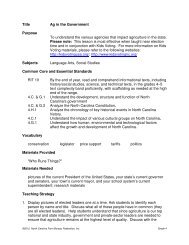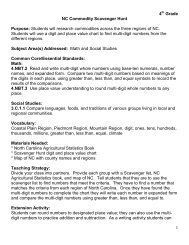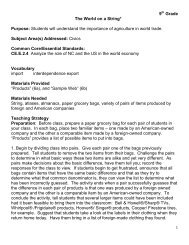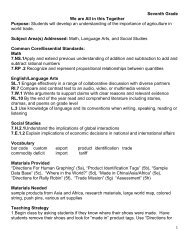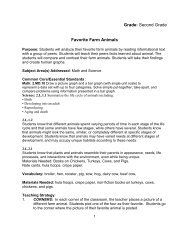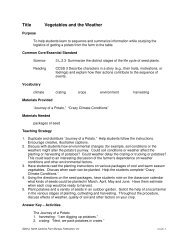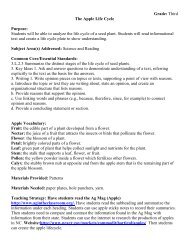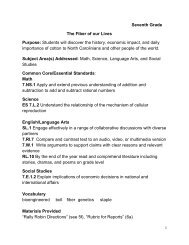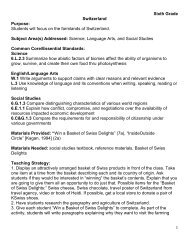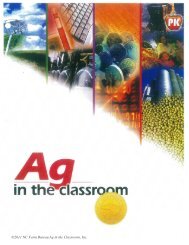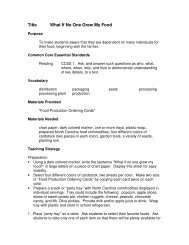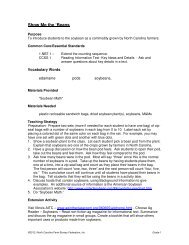Lesson Plan 9 - Cow 'Bout That! - Ag in the Classroom
Lesson Plan 9 - Cow 'Bout That! - Ag in the Classroom
Lesson Plan 9 - Cow 'Bout That! - Ag in the Classroom
Create successful ePaper yourself
Turn your PDF publications into a flip-book with our unique Google optimized e-Paper software.
(1) tape two pieces of chart paper to <strong>the</strong> wall, chalkboard, etc.; (2) draw two<strong>in</strong>tersect<strong>in</strong>g circles (like a Venn diagram) on <strong>the</strong> chart paper; (3) tape <strong>the</strong>"Beef <strong>Cow</strong>" picture to <strong>the</strong> left of one circle of <strong>the</strong> Venn diagram and <strong>the</strong>"Dairy <strong>Cow</strong>" picture to <strong>the</strong> right of <strong>the</strong> o<strong>the</strong>r circle mak<strong>in</strong>g it clear wherestudents will put <strong>the</strong> beef products and where <strong>the</strong>y will put <strong>the</strong> diaryproducts; (4) leave a roll of tape for students to use dur<strong>in</strong>g <strong>the</strong> activity; and(5) create two sets of cow product cards by writ<strong>in</strong>g <strong>the</strong> names of <strong>the</strong> variouscow products from “Corral By-Product Facts – Beef <strong>Cow</strong>s” and “Corral By-Product Facts – Dairy <strong>Cow</strong>s” plus “glue,” “lea<strong>the</strong>r,” “fertilizer” and “medic<strong>in</strong>e”on <strong>in</strong>dex cards; place a stack of cow products, for each team’s easy accesson team table/desk, etc.• Us<strong>in</strong>g cardstock, make two sets each of "Corral By-Product Facts – Beef<strong>Cow</strong>s" and "Corral By-Product Facts – Dairy <strong>Cow</strong>s." Cut <strong>in</strong>to cards.Separate <strong>in</strong>to two stacks, each stack conta<strong>in</strong><strong>in</strong>g <strong>the</strong> same products. Shuffleeach stack to ensure that <strong>the</strong> order is mixed. These will be used by <strong>the</strong>"corrall<strong>in</strong>g" teams.• On two large sheets of butcher paper, draw a Venn diagram, mark<strong>in</strong>g one“Before” and <strong>the</strong> o<strong>the</strong>r “After.” Make enough copies of "<strong>Cow</strong> <strong>'Bout</strong> <strong>That</strong>!" foreach student. Tape up two pieces of chart paper, dist<strong>in</strong>ct from those <strong>in</strong> <strong>the</strong>"corrals," and write "Before" at <strong>the</strong> top of one and "After" at <strong>the</strong> top of <strong>the</strong>o<strong>the</strong>r.• Review <strong>in</strong>formation about MyPlate at www.choosemyplate.gov.1. By show of hands, ask students if <strong>the</strong>y like milk, cheese, hamburger, steaks,etc. Ask <strong>the</strong>m where <strong>the</strong>y th<strong>in</strong>k <strong>the</strong>se products are derived. Answers willvary. Students should conclude that <strong>the</strong> products come from cows. Askstudents if <strong>the</strong>y th<strong>in</strong>k <strong>the</strong> products come from <strong>the</strong> same type of cow. Allowstudents time to explore <strong>the</strong>ir positions. Have students suggest ways <strong>in</strong>which cows could be different (coat color, gender, weight, etc.). If needed,prompt by ask<strong>in</strong>g <strong>the</strong>m to consider some of <strong>the</strong> noticeable differencesbetween <strong>the</strong>mselves and <strong>the</strong>ir classmates. Write <strong>the</strong>ir responses perta<strong>in</strong><strong>in</strong>gto cows on <strong>the</strong> chart paper labeled “Before.” Inform students that <strong>the</strong>y willbe explor<strong>in</strong>g <strong>the</strong> differences between cows <strong>in</strong> more detail.2. Divide students <strong>in</strong>to two teams. Distribute "Corral By-Product Facts,"scissors, glue or tape, and pla<strong>in</strong> white paper (2 pieces per students). Giveoral <strong>in</strong>structions. Solve <strong>the</strong> addition problems <strong>in</strong> <strong>the</strong> corner of each box andwrite <strong>the</strong> answer <strong>in</strong> <strong>the</strong> circle after <strong>the</strong> "=." Cut out each box. Us<strong>in</strong>g <strong>the</strong>numbers <strong>in</strong> <strong>the</strong> circle, match like answers. Tape or glue match<strong>in</strong>g boxestoge<strong>the</strong>r to form a longer, complete fact sentence strip. Read <strong>the</strong> fact.Notice <strong>the</strong> product name <strong>in</strong> <strong>the</strong> lower right-hand corner of each fact strip and<strong>the</strong> word "beef" or "dairy" pr<strong>in</strong>ted <strong>in</strong> <strong>the</strong> lower left-hand corner. For example,one strip might have <strong>the</strong> word “milk” <strong>in</strong> <strong>the</strong> lower right-hand corner and <strong>the</strong>word “dairy” pr<strong>in</strong>ted <strong>in</strong> <strong>the</strong> o<strong>the</strong>r corner. Students should deduce that <strong>the</strong>fact strip refers to a dairy cow and one dairy cow product is milk. Us<strong>in</strong>g <strong>the</strong>numbers <strong>in</strong> <strong>the</strong> circle, glue or tape <strong>the</strong> fact strips, <strong>in</strong> chronological order, to<strong>the</strong> pla<strong>in</strong> white paper. Two pieces of paper will be needed. All 8 strips of©2012, North Carol<strong>in</strong>a Farm Bureau Federation, Inc Grade 1
each fact sheet should fit on one piece of paper. When f<strong>in</strong>ished, studentswill have two fact sheets, one for beef cows and <strong>the</strong> o<strong>the</strong>r for dairy cows.Have students write <strong>the</strong>ir names on both fact sheets and put <strong>the</strong>m <strong>in</strong>"safekeep<strong>in</strong>g" until <strong>the</strong> next activity is completed.3. Inform teams that <strong>the</strong>y will "corral" beef and dairy cow products and that <strong>the</strong>first team to successfully complete "corrall<strong>in</strong>g" will receive a special dairyproduct treat. Rem<strong>in</strong>d students of <strong>the</strong> importance of teamwork and that <strong>the</strong>success of a team depends on <strong>the</strong> full cooperation of each <strong>in</strong>dividualmember. Communication, cooperation, and work<strong>in</strong>g towards a commongoal are all aspects of a successful team. Allow teams to choose names.Write team names on <strong>the</strong> chart paper <strong>in</strong> respective corrals. Afteremphasiz<strong>in</strong>g teamwork, give oral <strong>in</strong>structions for team corrall<strong>in</strong>g. Official"corrall<strong>in</strong>g" does not beg<strong>in</strong> until you say "GO!" Teams will work toge<strong>the</strong>r todeterm<strong>in</strong>e which products <strong>in</strong> <strong>the</strong> stack of "<strong>Cow</strong> Products" are beef and whichare dairy. Beef products will be taped <strong>in</strong> <strong>the</strong> "Beef <strong>Cow</strong>" corral and dairyproducts will be taped <strong>in</strong> <strong>the</strong> "Dairy <strong>Cow</strong>" corral. Inform students that four of<strong>the</strong> products <strong>in</strong> <strong>the</strong>ir stacks come from both beef and dairy cows. These fourproducts are not represented on “Corral By-Product Facts.” Expla<strong>in</strong> thatboth corrals are Venn diagrams. Expla<strong>in</strong> what a Venn diagram is and how itis designed to be used to show various th<strong>in</strong>gs. Demonstrate how to placeproducts that come from both beef and dairy cows <strong>in</strong> <strong>the</strong> <strong>in</strong>tersect<strong>in</strong>gsegment of <strong>the</strong> Venn diagram. Give teams time to decide <strong>the</strong> most effectivemethod of "corrall<strong>in</strong>g" <strong>the</strong> products before beg<strong>in</strong>n<strong>in</strong>g. Do not let teams flipthrough <strong>the</strong> stack of "<strong>Cow</strong> Products" until you say "GO!" The first team tocomplete <strong>the</strong> "corral" will sit down, ei<strong>the</strong>r on <strong>the</strong> floor <strong>in</strong> front of <strong>the</strong>ir corral or<strong>in</strong> <strong>the</strong>ir. Oppos<strong>in</strong>g team should cont<strong>in</strong>ue "corrall<strong>in</strong>g" until it is establishedthat <strong>the</strong> first team has correctly placed each product. Once this has beenestablished, <strong>the</strong> w<strong>in</strong>n<strong>in</strong>g team is served <strong>the</strong> dairy product treat first.4. Have students return to <strong>the</strong>ir desks/tables. As a class, review <strong>the</strong> beef anddairy cow products displayed <strong>in</strong> <strong>the</strong> team "corrals." Make sure studentsknow what <strong>the</strong> various items are. Have volunteers read <strong>the</strong>ir completedchronological "Corral By-Product Facts" aloud. Have students note <strong>the</strong>similarities and differences between beef and dairy cows. Use Background<strong>in</strong>formation for re<strong>in</strong>forcement and cont<strong>in</strong>ue discuss<strong>in</strong>g beef and dairy cows,<strong>the</strong>ir products, and <strong>the</strong> differences between <strong>the</strong>m. Refer students to <strong>the</strong> listof differences compiled before <strong>the</strong> activity. Now how do <strong>the</strong>y th<strong>in</strong>k cows canbe different? Write <strong>the</strong>ir responses on <strong>the</strong> chart paper labeled "After."Discuss <strong>the</strong> products that come from both beef and dairy cows (glue,fertilizer, medic<strong>in</strong>e, lea<strong>the</strong>r). How are <strong>the</strong>se products different from <strong>the</strong> o<strong>the</strong>rproducts? Lead students to conclude that <strong>the</strong>y are non-food products anddiscuss <strong>the</strong> relevance. Distribute "<strong>Cow</strong> <strong>'Bout</strong> <strong>That</strong>!" as a review.Extension Activity1. Instruct <strong>the</strong> class on <strong>the</strong> food guide, MyPlate. Discuss <strong>the</strong> fact that beef anddairy cattle represent two important pyramid groups: meat and dairy.Fur<strong>the</strong>rmore, meat (<strong>in</strong> this case, beef), is significant because of <strong>the</strong> prote<strong>in</strong>©2012, North Carol<strong>in</strong>a Farm Bureau Federation, Inc Grade 1
and o<strong>the</strong>r vitam<strong>in</strong>s and m<strong>in</strong>erals it provides us. Prote<strong>in</strong> builds strongmuscles. Dairy products provide calcium needed to build strong muscles.Dairy products provide calcium needed to build strong bones and teeth.Distribute "How to Make a Muscle and Bone Build<strong>in</strong>g Burger." Have classwrite <strong>the</strong> directions for mak<strong>in</strong>g a cheeseburger, mak<strong>in</strong>g sure to use <strong>the</strong>words from <strong>the</strong> word box. The ma<strong>in</strong> <strong>in</strong>gredients of this burger arehamburger meat (or ground beef) and cheese; <strong>the</strong> rest is up to <strong>the</strong> student.Rem<strong>in</strong>d <strong>the</strong>m that <strong>the</strong>y should write <strong>the</strong>ir directions for someone who hasnever made a burger. Emphasize that anyone should be able to follow gooddirections and get <strong>the</strong> desired results.2. Supply enough milk cartons for every student. Have an equal share of skim,2%, whole, and chocolate milk cartons, if possible. Refer students to <strong>the</strong>back of <strong>the</strong> carton where <strong>the</strong> nutritional <strong>in</strong>formation is located. Informstudents that <strong>the</strong> FDA (Food and Drug Adm<strong>in</strong>istration) requires packagedfoods to display <strong>in</strong>formation about <strong>the</strong> product on <strong>the</strong> food label <strong>in</strong> order toprotect consumers. Def<strong>in</strong>e consumers. Be sure to acknowledge <strong>the</strong>ir role asconsumers. Tell students that all food labels must conta<strong>in</strong> <strong>the</strong> commonname of <strong>the</strong> product, name and address of <strong>the</strong> product's manufacturer, netcontents <strong>in</strong> terms of weight, measure, or count, <strong>in</strong>gredient list, serv<strong>in</strong>g sizes,and nutrition facts. As a class, locate each required part of <strong>the</strong> label anddiscuss. Compare <strong>the</strong> <strong>in</strong>formation on <strong>the</strong> various milk cartons. Askstudents how <strong>the</strong> various k<strong>in</strong>ds of milk differ from one ano<strong>the</strong>r. Does onehave more calories <strong>in</strong> a serv<strong>in</strong>g than <strong>the</strong> o<strong>the</strong>rs? Do <strong>the</strong>y all conta<strong>in</strong> <strong>the</strong>same amount of calcium, prote<strong>in</strong>, etc? Are <strong>the</strong> <strong>in</strong>gredients <strong>the</strong> same?Determ<strong>in</strong>e <strong>the</strong> most significant differences between <strong>the</strong> milk types.Nutritionally, which is <strong>the</strong> best for <strong>the</strong> consumer? Ask students which is <strong>the</strong>irfavorite k<strong>in</strong>d of milk.3. Contact your county Farm Bureau for assistance <strong>in</strong> sett<strong>in</strong>g up a farm tour ata local beef and/or dairy cattle operation. Ideally, you would visit both -which might prove to be at <strong>the</strong> same location – so that your class couldmake comparisons between <strong>the</strong> two. If only able to visit one or <strong>the</strong> o<strong>the</strong>r,discuss <strong>the</strong> differences with <strong>the</strong> farmer at <strong>the</strong> tour site. Be sure to reviewwith students beforehand, so that <strong>the</strong>y can be active participants <strong>in</strong> this onsitediscussion.Background InformationCattle, collectively, are male and female. Only female cattle, or cows,produce milk. They beg<strong>in</strong> produc<strong>in</strong>g milk after giv<strong>in</strong>g birth to <strong>the</strong>ir first calf(baby cow). <strong>Cow</strong>s that are able to produce large quantities of milk are raisedas dairy cows. Cattle that are more muscular are raised as beef cattle. Beefcows produce milk, but only enough to nurture <strong>the</strong>ir young. Male cows arealso used <strong>in</strong> beef production. Can <strong>the</strong>y be used <strong>in</strong> dairy production? (No,because male cows do not produce milk).Beef and dairy cow production <strong>in</strong> North Carol<strong>in</strong>a are two dist<strong>in</strong>ct <strong>in</strong>dustriesbecause of <strong>the</strong> trait differences mentioned above (milk production <strong>in</strong> large©2012, North Carol<strong>in</strong>a Farm Bureau Federation, Inc Grade 1
quantities vs. more muscular). North Carol<strong>in</strong>a beef production occurs <strong>in</strong> allareas of <strong>the</strong> state as ei<strong>the</strong>r a full time or a supplemental enterprise. Thedairy <strong>in</strong>dustry, demonstrat<strong>in</strong>g <strong>the</strong> chang<strong>in</strong>g role of agriculture through itsdecreased farm numbers and <strong>in</strong>creased milk production, is primarily located<strong>in</strong> <strong>the</strong> upper Piedmont and mounta<strong>in</strong> foothills of North Carol<strong>in</strong>a.The cow that produced 1,500 quarts of milk a year a hundred years agoproduces 7,812 quarts a year today. (One first grade student would have todr<strong>in</strong>k 85 plus cartons of milk a day for an entire year to equal this amount!).The dairy cows are milked two to three times a day, depend<strong>in</strong>g on <strong>the</strong> farm,<strong>in</strong> a build<strong>in</strong>g called a milk<strong>in</strong>g parlor. Automatic milk<strong>in</strong>g mach<strong>in</strong>es are used.How was a cow milked a 100 years ago?Most beef cattle herds <strong>in</strong> North Carol<strong>in</strong>a are small, consist<strong>in</strong>g of 50 or fewercattle. The term "cattle ranch" is not accurate for North Carol<strong>in</strong>a. Anaverage dairy farm <strong>in</strong> North Carol<strong>in</strong>a has about 110 cows. In 1997, beefcattle products ranked 8 th while dairy products ranked 10 th <strong>in</strong> major NC farmcommodities (current rank<strong>in</strong>gs can be confirmed with <strong>the</strong> North Carol<strong>in</strong>aDepartment of <strong>Ag</strong>riculture at http://www.agr.state.nc.us/stats).Both <strong>in</strong>dustries are highly regulated. Stages of regulation occur <strong>in</strong> <strong>the</strong> <strong>in</strong>itialcare of <strong>the</strong> livestock on <strong>the</strong> farm, <strong>the</strong> process<strong>in</strong>g of <strong>the</strong> product whe<strong>the</strong>r it isbeef or dairy, and <strong>the</strong> proper packag<strong>in</strong>g and label<strong>in</strong>g of <strong>the</strong> product.Ultimately, <strong>the</strong> result is a consumer-safe product.Bov<strong>in</strong>e Medic<strong>in</strong>es – Bov<strong>in</strong>e refers to cattle; bov<strong>in</strong>e medic<strong>in</strong>es are derivedfrom cattle. Some are: Cortisone (hormone from <strong>the</strong> liver); Estrogen(hormones from <strong>the</strong> ovaries; Hyperimmune Bov<strong>in</strong>e Colostrum (compoundderived from <strong>the</strong> colostrums of post-natal cows); Cartilage (used <strong>in</strong> treat<strong>in</strong>gosteoarthritis and rheumatoid arthritis); Bov<strong>in</strong>e <strong>in</strong>sul<strong>in</strong> (from <strong>the</strong> pancreas).The first vacc<strong>in</strong>e for small pox (totally eradicated by 1980) came from a cow<strong>in</strong>fected with cowpox.©2012, North Carol<strong>in</strong>a Farm Bureau Federation, Inc Grade 1
Beef <strong>Cow</strong>©2012, North Carol<strong>in</strong>a Farm Bureau Federation, Inc Grade 1
Dairy <strong>Cow</strong>©2012, North Carol<strong>in</strong>a Farm Bureau Federation, Inc Grade 1
Corral By-Product Facts – Beef <strong>Cow</strong>s2+5=They only produce enough milkbeef3+0=Silage is made by chopp<strong>in</strong>g upbeef4+4=We get many productsbeef1+0=large amounts of milk.graze <strong>in</strong> <strong>the</strong> pasture.cows when it is cold outside.3+3=hamburger0+1=steak2+2=ribs2+0=In <strong>the</strong> summer, cowsbeef1+3=<strong>the</strong> farmer feeds <strong>the</strong> cows silage.pot roast3+2=The farmer must provide shelter forbeef1+1=When <strong>the</strong> wea<strong>the</strong>r is cold,beef2+4=heavily muscled.to nurture <strong>the</strong>ir young.cubed steak4+3=prime rib2+1=They do not producebeef1+4=immature corn (ears, leaves, and stalk).meatloaf3+5=Beef cows arebeeffrom beef cows.roast beef©2012, North Carol<strong>in</strong>a Farm Bureau Federation, Inc Grade 1
Corral By-Product Facts – Dairy <strong>Cow</strong>s2+0=They eat silage, grass, alfalfa,dairy5+1=Their bodies start mak<strong>in</strong>g milk afterdairy0+3=Silage is made by chopp<strong>in</strong>g updairy0+1=<strong>Cow</strong>s like todairy2+3=about 100 glasses of milk a day.graze <strong>in</strong> <strong>the</strong> pasture.<strong>the</strong>y have a baby calf.clover, wheat, and hay.5+0=milk1+0=cheese4+2=butter1+1=yogurt7+1=Dairy cows use food to producedairy6+1=The milk is made <strong>in</strong> a sackdairy2+6=When <strong>the</strong> udder is full of milk, <strong>the</strong> dairy cowdairy4+0=Many farmers raise crops todairyis milked – normally once <strong>in</strong> <strong>the</strong> morn<strong>in</strong>g andonce <strong>in</strong> <strong>the</strong> even<strong>in</strong>g.ice cream0+7=under <strong>the</strong>ir bellies called an udder.whipp<strong>in</strong>g cream3+1=feed <strong>the</strong> cows – usually hay and silage.buttermilk1+2=<strong>the</strong> immature ears, leaves, and stalk of corn.milk chocolate candy©2012, North Carol<strong>in</strong>a Farm Bureau Federation, Inc Grade 1
Where’s <strong>the</strong> Milk? Got Beef?1. Circle <strong>the</strong> correct answerMale cows produce milk.TRUEFALSE2. Circle <strong>the</strong> correct answer.Silage is chopped up corn.TRUEFALSE3. Circle <strong>the</strong> word that completes <strong>the</strong>sentence.Dairy cows produce large quantities of ________.steaks milk ice cream corn4. Circle <strong>the</strong> word that completes <strong>the</strong>sentence.Beef cows are more ______ than dairy cows.brown cute muscular5. Complete <strong>the</strong> sentence. __________ cows are milked 2 to 3 times a day.6. Circle <strong>the</strong> word that completes <strong>the</strong>sentence.Beef and dairy cows like to _____<strong>in</strong> <strong>the</strong> pasture.sleep play graze swim7. Circle all beef products8. Circle all dairy products.©2012, North Carol<strong>in</strong>a Farm Bureau Federation, Inc Grade 1
How to Make a Muscle and Bone Build<strong>in</strong>g BurgerDraw a picture of <strong>the</strong> f<strong>in</strong>ished burger on <strong>the</strong> back of this sheet.©2012, North Carol<strong>in</strong>a Farm Bureau Federation, Inc Grade 1
©2012, North Carol<strong>in</strong>a Farm Bureau Federation, Inc Grade 1



